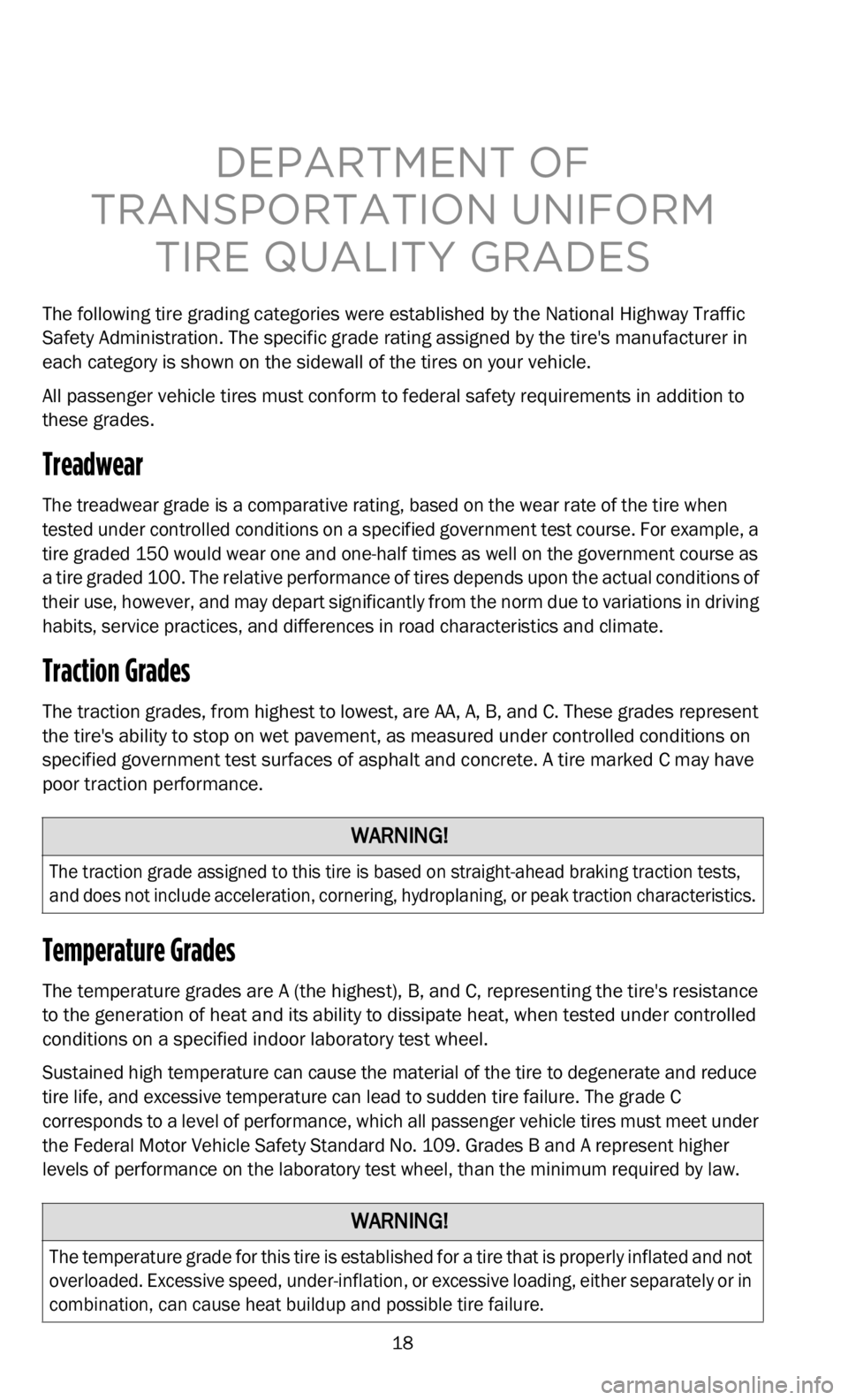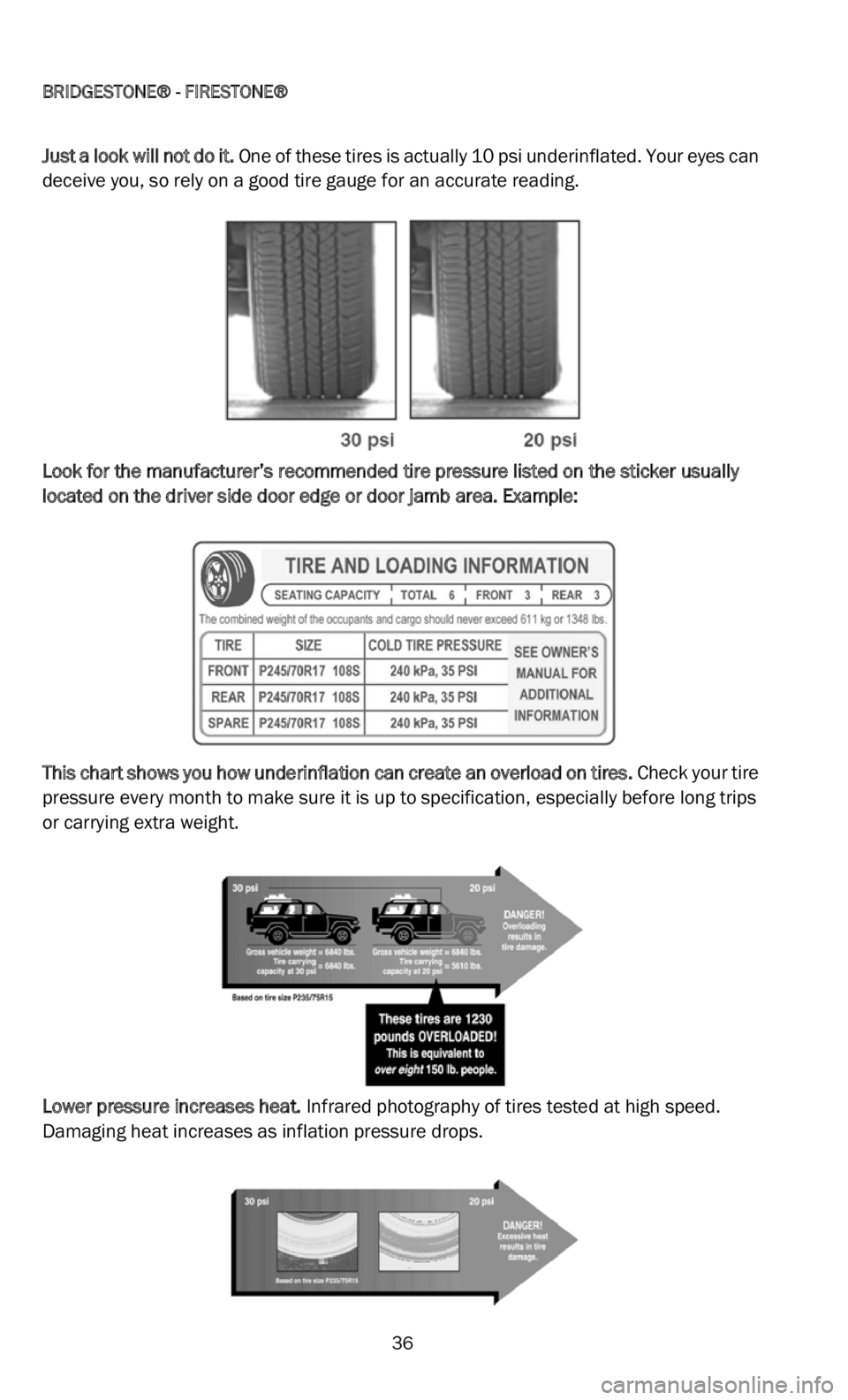ESP DODGE DURANGO 2022 Vehicle Warranty
[x] Cancel search | Manufacturer: DODGE, Model Year: 2022, Model line: DURANGO, Model: DODGE DURANGO 2022Pages: 200, PDF Size: 6.72 MB
Page 4 of 200

TIRES
3
Tire Sizing Chart
EXAMPLE:
Example Size Designation: P215/65R15XL 95H, 215/65R15 96H, LT235/85R16C,
T1 4
5/80D18 103M, 31x10.5 R15 LT
P = Passenger car tire size based on US design standards, or
"....blank...." =
Passenger car tire based on European design standards, or
LT = Light Truck tire based on US design standards, or
T
or S = Temporary spare tire or
3 1 =
Overall diameter in inches (in)
2 1
5, 235, 145 =
Section width in millimeters (mm)
65, 85, 80 = Aspect ratio in percent (%)
• Ra
tio of section height to section width of tire, or 10
.5 = Section width in inches (in)
R = Construction code
• "R" means radial construction, or
• "D
" means diagonal or bias construction
1 5
, 16, 18 = Rim diameter in inches (in)
S e
rvice Description:
95 = Load Index
• A
numerical code associated with the maximum load a tire can carry
H
= Speed Symbol
• A symbol indicating the range of speeds at which a tire can carry a load corre -
s p
onding to its load index under certain operating conditions
• The maximum speed corresponding to the speed symbol should only be achieved un
der specified operating conditions (i.e., tire pressure, vehicle loading, road condi -
tions, and posted speed limits)
Load Identification:
Absence of the following load identification symbols on the sidewall of the tire
in d
icates a Standard Load (SL) tire:
• XL = Extra load (or reinforced) tire, or
• LL =
Light load tire or
• C, D, E, F, G =
Load range associated with the maximum load a tire can carry at a
specified pressure
Maximum Load –
Maximum load indicates the maximum load this tire is designed to
carry
Maximum Pressure –
Maximum pressure indicates the maximum permissible cold tire
inflation pressure for this tire
Page 10 of 200

TIRES
9
Tires — General Information
Tire Pressure
Proper tire inflation pressure is essential to the safe and satisfactory operation of your
vehicle. Four primary areas are affected by improper tire pressure:
• Safety and Vehicle Stability
• Ec
onomy
• Tr
ead Wear
• Ri
de Comfort
S a
fety
Both underinflation and overinflation affect the stability of the vehicle and can produce
a f
eeling of sluggish response or over responsiveness in the steering.
NOTE:
• U nequal tire pressures from side to side may cause erratic and unpredictable steering
r e
sponse.
• Unequal tire pressure from side to side may cause the vehicle to drift left or right.
F u
el Economy
Underinflated tires will increase tire rolling resistance, resulting in higher fuel
co n
sumption.
WARNING!
• Improperly inflated tires are dangerous and can cause collisions.
• Underinflation increases tire flexing and can result in overheating and tire failure.
•Ov
erinflation reduces a tire's ability to cushion shock. Objects on the road and chuck -
h o
les can cause damage that result in tire failure.
• Overinflated or underinflated tires can affect vehicle handling and can fail suddenly, re
sulting in loss of vehicle control.
• Unequal tire pressures can cause steering problems. You could lose control of your ve
hicle.
• Unequal tire pressures from one side of the vehicle to the other can cause the ve
hicle to drift to the right or left.
• Always drive with each tire inflated to the recommended cold tire inflation pressure.
Page 11 of 200

TIRES
10
Tread Wear
Improper cold tire inflation pressures can cause abnormal wear patterns and reduced
tre
ad life, resulting in the need for earlier tire replacement.
Ride Comfort And Vehicle Stability
Proper tire inflation contributes to a comfortable ride. Overinflation produces a jarring
and
uncomfortable ride.
Tire Inflation Pressures
The proper cold tire inflation pressure is listed on the driver side B-pillar or rear edge of
the driver side door.
At least once a month:
• Check and adjust tire pressure with a good quality pocket-type pressure gauge. Do notma
ke a visual judgement when determining proper inflation. Tires may look properly
inflated even when they are underinflated.
• Inspect tires for signs of tire wear or visible damage.
I n
flation pressures specified on the placard are always “cold tire inflation pressure”. Cold
ti r
e inflation pressure is defined as the tire pressure after the vehicle has not been driven
for at least three hours, or driven less than 1 mile (1.6 km) after sitting for a minimum of
th r
ee hours. The cold tire inflation pressure must not exceed the maximum inflation
pressure molded into the tire sidewall.
Check tire pressures more often if subject to a wide range of outdoor temperatures, as
ti r
e pressures vary with temperature changes.
Tire pressures change by approximately 1 psi (7 kPa) per 12°F (7°C) of air temperature
ch a
nge. Keep this in mind when checking tire pressure inside a garage, especially in the
Winter.
Example: If garage temperature = 68°F (20°C) and the outside temperature = 32°F
(0 °
C), then the cold tire inflation pressure should be increased by 3 psi
(21 kPa), which equals 1 psi (7 kPa) for every 12°F (7°C) for this outside temperature
c o n
dition.
Tire pressure may increase from 2 to 6 psi (13 to 40 kPa) during operation. DO NOT
re d
uce this normal pressure build up or your tire pressure will be too low.
CAUTION!
After inspecting or adjusting the tire pressure, always reinstall the valve stem cap. This
will prevent moisture and dirt from entering the valve stem, which could damage the
valve stem.
Page 19 of 200

18
DEPARTMENT OF
TRANSPORTATION UNIFORM TIRE QUALITY GRADES
The following tire grading categories were established by the National Highway Traffic
Safety Administration. The specific grade rating assigned by the tire's manufacturer in
each category is shown on the sidewall of the tires on your vehicle.
All passenger vehicle tires must conform to federal safety requirements in addition to
the
se grades.
Treadwear
The treadwear grade is a comparative rating, based on the wear rate of the tire when
tested under controlled conditions on a specified government test course. For example, a
tire graded 150 would wear one and one-half times as well on the government course as
a tire graded 100. The relative performance of tires depends upon the actual conditions of
their use, however, and may depart significantly from the norm due to variations in driving
habits, service practices, and differences in road characteristics and climate.
Traction Grades
The traction grades, from highest to lowest, are AA, A, B, and C. These grades represent
the tire's ability to stop on wet pavement, as measured under controlled conditions on
specified government test surfaces of asphalt and concrete. A tire marked C may have
poor traction performance.
Temperature Grades
The temperature grades are A (the highest), B, and C, representing the tire's resistance
to the generation of heat and its ability to dissipate heat, when tested under controlled
conditions on a specified indoor laboratory test wheel.
Sustained high temperature can cause the material of the tire to degenerate and reduce
tir
e life, and excessive temperature can lead to sudden tire failure. The grade C
corresponds to a level of performance, which all passenger vehicle tires must meet under
the Federal Motor Vehicle Safety Standard No. 109. Grades B and A represent higher
levels of performance on the laboratory test wheel, than the minimum required by law.
WARNING!
The traction grade assigned to this tire is based on straight-ahead braking traction tests,
and does not include acceleration, cornering, hydroplaning, or peak traction characteristics.
WARNING!
The temperature grade for this tire is established for a tire that is properly inflated and not
overloaded. Excessive speed, under-inflation, or excessive loading, either separately or in
combination, can cause heat buildup and possible tire failure.
Page 23 of 200

BFGOODRICH® TIRES
22
• The adding of liquid, solid or gaseous materials other than air, nitrogen or carbon dioxide for example, waterbase sealers or balancing substances
• O zone or weather checking
HOW REPLACEMENT CHARGES ARE CALCULATED
Passenger And Light Truck Tires Workmanship/Materials
A tire which becomes unserviceable due to a condition covered by this workmanship and
ma
terials limited warranty will be replaced with a comparable new BFGoodrich® brand
tire, free of charge, when 2/32 of an inch (1.6 mm) or less of the original tread is worn,
( o
r 25% or less, whichever is more beneficial to you) and within 12 months of the date of
p u
rchase. The cost of mounting and balancing the tire is included. You pay the cost of
any other service charges and applicable taxes.
When more than 2/32 of an inch (1.6 mm) of the original tread has been worn (or more
t h
an 25%, whichever is more beneficial to you) or after 12 months from the date of
p u
rchase, you must pay the cost of a comparable new BFGoodrich® brand passenger or
light truck replacement tire on a prorated basis. The retailer shall determine the charge
by multiplying the percentage of the original usable tread worn by the current selling
price at the adjustment location or the price on the current BFGoodrich® brand Base
Price List, whichever is lower. This list is based on a predetermined price intended to
fairly represent the actual selling price of the tire.
You pay the cost of mounting, balancing, and or any other service charges and applicable
t a
xes.
WHAT YOU MUST DO WHEN MAKING A CLAIM
When making a claim under the terms of this limited warranty you must present your
tire(s), your vehicle, and your original invoice to a participating BFGoodrich® brand tire
retailer. BFGoodrich® brand tire retailers are listed in the yellow pages under “Tire
Dealers-Retail”. Personal identification (i.e. Driver’s License, Credit Card, etc.) and
vehicle registration may be required. You pay any service charges for normal vehicle and
tire maintenance.
CONDITIONS AND EXCLUSIONS
This limited warranty does not provide compensation for loss of time, loss of use of
vehicle, inconvenience or incidental or consequential damages.
Tires presented for claim remain the property of the consumer and BFGoodrich® brand
a c
cepts no responsibility for loss of, or damage to, tires which are in the custody or
control of a BFGoodrich® tire retailer for the purpose of inspection for warranty
adjustment.
In the event of a disputed claim, the consumer must make the tire available for further
i n
spection. Tires accepted for claim become the property of Michelin North America Inc.
No BFGoodrich® brand representative, employee or retailer has the authority to make or
i m
ply any representation, promise or agreement, which in any way varies from the terms
of this limited warranty. This limited warranty applies only in the United States and Canada.
Page 26 of 200

BFGOODRICH® TIRES
25
TIRE PRESSURE MONITORING SYSTEM (TPMS)
Your vehicle may be equipped with a Tire Pressure Monitoring System (TPMS) that is
designed to monitor the pressure of tires mounted on your vehicle and sends a signal to
the driver if a tire pressure falls below a predetermined level. A TPMS should not replace
monthly manual pressure checks for all four tires and the spare. We recommend that you
manually monitor and check tire pressure inflation with a pressure gauge.
Your tires should have the recommended pressure listed by your vehicle’s manufacturer.
Th
is information can be found in the vehicle Owner’s Manual and often on a placard
located in the vehicle’s door jamb, inside the fuel hatch, or on the glove compartment
door. If you have a plus size fitment that requires a higher inflation pressure, your TPMS
will require re-calibration to the new inflation pressure. Refer to your tire dealer/installer
of plus size tires for proper inflation pressure.
We recommend checking air pressure once each month, and before a long trip. Whether
y o
u have a full-sized or mini-spare, make sure that it is properly inflated as well. If the
TPMS generates improper monitoring or signals we recommend that you consult your
Owner’s Manual provided with your vehicle and follow up with FCA US LLC.
TIRE SPINNING
Do not spin wheels in excess of 35 mph (55 km/h) as indicated on the speedometer.
Ex
cessive speed in a free-running, unloaded tire can cause it to “explode” from
centrifugal force. The energy released by such an explosion is sufficient to cause serious
physical injury or death. Never allow anyone to stand near or behind the spinning tire.
When in mud, sand, snow, ice or other slippery conditions, do not engage in excessive
w h
eel spin. Accelerating the motor excessively, particularly with automatic transmission
vehicles, may cause a drive tire that has lost traction to spin beyond its speed capability.
This is also true when balancing a drive tire/wheel assembly on the vehicle using the
vehicle engine to spin the tire/wheel assembly.
HIGH SPEED DRIVING CAN BE DANGEROUS
Correct inflation pressure is especially important. However, at high speeds, even with the
correct inflation pressure, a road hazard, for example is more difficult to avoid and if
contact is made, has a greater chance of causing tire damage than at a lower speed.
Moreover, driving at high speed reduces the reaction time available to avoid accidents
and bring your vehicle to a safe stop.
If you see any damage to a tire or wheel, replace it with the spare at once and visit a
pa
rticipating BFGoodrich® Tire Retailer.
Exceeding the maximum speeds shown on the following page for each type of
B F
Goodrich® tire will cause the tire to build up excessive heat which can cause tire
damage that could result in sudden tire destruction and rapid air loss. Failure to control
a vehicle when one or more tires experience a sudden air loss can lead to an accident.
In any case, you should not exceed reasonable speeds as indicated by the legal limits
a n
d driving conditions.
Page 27 of 200

BFGOODRICH® TIRES
26
SPEED RATINGS
Speed Symbols are shown on the sidewall of some BFGoodrich® tires. The following
table shows the maximum speed corresponding to the symbol.
*Some V (or VR) rated tires may have a speed capacity greater than 149 mph (240 km/h).
C o
nsult your participating BFGoodrich® tire retailer for maximum speed rating if your
vehicle capability exceeds this speed.
**Z (or ZR) rated tires are designed to be used on cars with maximum speed capabilities
i n
excess of 149 mph (240 km/h).
W and Y speed ratings are sub-categories of Z.
Consult your BFGoodrich® tire retailer for maximum speed capabilities.
Although a tire may be speed-rated, we do not endorse the operation of any vehicle in an
u n
safe or unlawful manner. Speed ratings are based on laboratory tests which relate to
performance on the road, but are not applicable if tires are underinflated, overloaded,
worn out, damaged, altered, improperly repaired, or retreaded. Furthermore, a tire’s
speed rating does not imply that vehicles can be safely driven at the maximum speed for
which the tire is rated, particularly under adverse road and weather conditions or if the
vehicle has unusual characteristics.
BFGoodrich® highway passenger tires that do not have a speed symbol on the sidewall
h a
ve a maximum speed rating of 105 mph (170 km/h). Light truck highway tires that do
n o
t have a speed symbol on the sidewall of the tire have a maximum speed rating of
87 mph (140 km/h).
The speed and other ratings of retreaded tires are assigned by the retreader and replace
t h
e original manufacturer’s ratings.
NOTE:
In order to maintain the speed capability of the vehicle, replacement tires must have
s p
eed ratings equal to or higher than those fitted as original equipment as indicated on
the vehicle tire placard or Owner’s Manual. If tires with lower speed ratings are fitted, the
vehicle’s handling may be affected and the speed capability of the vehicle will be lowered
to the maximum speed capability of the replacement tires as indicated in the following
table.
SPEED Ratings Maximum Speed
Km/h mph
M 130 81
N 140 87
P 150 93
Q 160 100
R 170 106
S 180 112
Page 28 of 200

BFGOODRICH® TIRES
27
REMEMBER — High speed driving can be dangerous and may damage your tires. AND —
When driving at highway speeds, correct inflation pressure is especially important.
INSPECT YOUR TIRES, DO NOT DRIVE ON A DAMAGED TIRE OR WHEEL
HAZARDS
Objects in the road, such as potholes, glass, metal, rocks, wood, debris and the like, can
d a
mage a tire and should be safely avoided. Unavoidable contact with such objects
should prompt a thorough tire inspection.
Anytime you see any damage to your tires or wheels, replace with the spare at once and
i m
mediately visit any BFGoodrich® tire retailer.
IMPACT DAMAGE
A tire impacted by a road hazard (curb, pothole, debris) may be damaged but not have
visible signs of damage on its surface. A tire damaged by an impact may sustain a
sudden failure a day, week, or even months later. You may not recall hitting an object that
damaged or injured your tires. Air loss, unusual tire wear, localized wear or vibrations can
also be signs of internal tire damage.
If you suspect any damage to your tire or wheel from an impact with a curb, pothole,
de
bris on the road or any other road hazard, or if you feel or hear any unusual vibration,
replace with a properly inflated spare at once and immediately visit any qualified tire
technician.
INSPECTION
When inspecting your tires, including the spare, check the air pressures. If the pressure
c h
eck indicates that one of your tires has lost pressure of two pounds or more, look for
signs of penetration, valve leakage or wheel damage that may account for the air loss.
Always look for bulges, cracks, cuts, penetrations and abnormal tire wear, particularly on
t h
e edges of the tire tread, which may be caused by misalignment or underinflation. If
any such damage is found, the tire must be inspected by your BFGoodrich® tire retailer
at once. Use of a damaged tire could result in tire failure and an accident. T
190 118
H 210 130
V 240 149
V* 240+ 149+
W 270168 ZR**
Y 300186 ZR**
300+ 186+ ZR**
SPEED Ratings Maximum Speed
Km/h mph
Page 30 of 200

BFGOODRICH® TIRES
29
It is especially important to check the vehicle manufacturer’s Owner’s Manual when
mixing, matching or replacing tires on 4 Wheel Drive (4WD) vehicles, as this may require
special precautions.
BFGOODRICH® DOES NOT RECOMMEND MIXING SELF SUPPORTING STRUCTURE (SSS)
T I
RES WITH NON-SSS TIRES OTHER THAN THE TEMPORARY USE OF THE SPARE TIRE.
WINTER DRIVING
Tires which meet the Rubber Manufacturers Association (RMA) definition of snow tires
are marked M/S, M&S. On such tires, this designation is molded into the sidewall. Tires
without this notation are not recommended for winter driving.
While All-Season tires are designed to provide reliable performance in
some winter conditions, the use of four winter tires is recommended for
op
timum performance. Tires designated for use in severe winter
conditions are marked on at least one sidewall with the letter “M” and “S”
plus a pictograph of a mountain with a snowflake on it.
TIRE ROTATION AND REPLACEMENT
To obtain maximum tire wear, it may be necessary to rotate your tires. Refer to your
vehicle Owner’s Manual for instructions on tire rotation. If you do not have an Owner‘s
Manual for your vehicle, BFGoodrich® recommends rotating your tires every 6,000 to
8,000 miles (10,000 to 12,000 km).
Monthly inspection for tire wear is recommended. Your tires should be rotated at the first
s i
gn of irregular wear, even if it occurs before 6,000 miles (10,000 km). This is true for
a l
l vehicles.
When rotating tires with a directional tread pattern, observe the arrows molded on the
s i
dewall which show the direction the tire should turn. Care must be taken to maintain
the proper turning direction.
Some Tire Pressure Monitoring Systems (TPMS) may not recognize that a tire has been
m o
ved to a different position on your vehicle. Make certain that your TPMS system is
reset, if necessary, so as to correctly identify the location of each tire on your vehicle.
Refer to your vehicle Owner’s Manual or your vehicle dealer.
Determine whether rotated tires require tire inflation adjustment as front and rear
p o
sition tire pressure may vary according to the vehicle manufacturer’s specification due
to the actual load on that wheel position. Some vehicles may have different sized tires
mounted on the front and rear axles, and these different sized tires have rotation
restrictions. Always check the vehicle Owner’s Manual for the proper rotation
recommendations.
FULL-SIZE SPARE
Full-size spare tires (not temporary spares) of the same size and construction should be
used in a five tire rotation. Always check the inflation pressure of the full-size spare
immediately before incorporating it into rotation. Follow the vehicle manufacturer’s
recommended pattern for rotation, or if not available, see a qualified tire technician.
Page 37 of 200

BRIDGESTONE® - FIRESTONE®
36
Just a look will not do it. One of these tires is actually 10 psi underinflated. Your eyes can
deceive you, so rely on a good tire gauge for an accurate reading.
Look for the manufacturer’s recommended tire pressure listed on the sticker usually
lo
cated on the driver side door edge or door jamb area. Example:
This chart shows you how underinflation can create an overload on tires. C
heck your tire
pressure every month to make sure it is up to specification, especially before long trips
or carrying extra weight.
Lower pressure increases heat. I
nfrared photography of tires tested at high speed.
Damaging heat increases as inflation pressure drops.